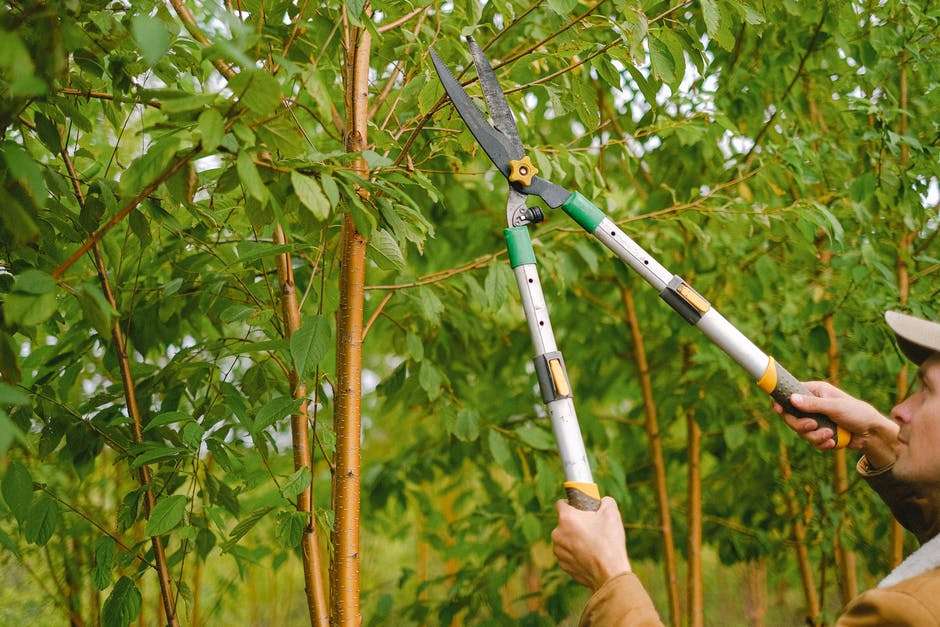Trees require regular trimming for many reasons, including health, safety, and aesthetics. Read on to find out how often you should have your trees pruned, when the best time to trim is, and more.

Why Do Your Trees Need to be Trimmed?
One of the most important reasons to trim trees regularly is safety. Dead, diseased, or broken branches can cause injury and property damage if not addressed proactively. Regular, proper tree pruning eliminates dead or damaged limbs to protect the people and structures underneath.
Another important reason to have your trees pruned regularly is for health reasons. Proper pruning will improve a tree’s overall health by allowing more nutrients to be accessible for the rest of the tree once unnecessary branches are removed, resulting in better leaves, blooms, and fruit if you have fruit trees.
Finally, dense canopies can block sunlight to shrubs and turf underneath. To improve the overall aesthetic of your landscape, strategically thinning out the canopy to allow more sunlight to penetrate is a good idea.
When Should Trees Be Trimmed?
Many people don’t know that timing is crucial when it comes to trimming trees. While we take a number of factors into consideration, generally, it is best to schedule your tree trimming between early winter and early spring, after a tree’s leaves have dropped and before its blooms appear. Trees should be trimmed on a regular basis, at least once every 2-3 years.
Trimming Young Trees
Trimming young trees is necessary to ensure that they continue to grow into a healthy, sturdy shape and size. Because they are about to begin their development cycle, the optimal time to trim young trees is late winter or early spring. Trimming young trees throughout their formative years means you won’t have to perform as much trimming later on.
Hedge Trimming and Shrub Trimming
Some people don’t count hedges as trees, but they’re an important part of many landscapes, especially as privacy screens.
Spring and summer are generally the best times to prune hedges, but we take a number of factors into consideration, including environment, species, and climate. Trimming some species at the wrong time can be detrimental to the plant’s health, which is why it’s a good idea to rely on a certified arborist for your hedge or shrub trimming needs.
Deciduous Trees
In late fall and early winter, deciduous tree species such as oak, maple, ash, and willow shed their leaves. These trees should be pruned when they are completely dormant, meaning late winter or very early spring, just before they flower, is the best time to prune.
How to Trim your Tree
Step 1: Hire a professional. RTEC always recommends allowing tree service professionals (supervised by a certified arborist) to trim your trees, rather than trying to do it yourself.
Step 2: If you think your tree is in need of pruning, consider your goals. Do you want to:
- Increase sunlight penetration?
- Prune branches away from your house or other structure?
- Clean out deadwood?
- Remove hazardous branches?
- Restore the crown after a trauma (like a storm)?
- Reduce weight?
- Improve aesthetics?
- Or something else?
Convey these goals to your certified arborist so we can create a customized plan for your tree pruning project.
If you are thinking about trimming your trees yourself, below are some of the risks of trying to DIY your tree pruning (or hiring the wrong company):
Damaging the tree beyond repair
The skillset required to execute proper tree pruning techniques takes years of schooling, training, and on-the-job experience to master. The average homeowner (or tree service, for that matter) does not have the skillset needed to prune your trees properly. Just because a company has the right equipment doesn’t mean they are able to do the work correctly.
Many tree services will engage in harmful pruning practices such as topping or lions-tailing. As a rule of thumb, if a tree service offers to top your trees, we recommend not calling them back!
Some tree services irreversibly damage your trees while trimming them by climbing your trees using spikes. This practice is obsolete for pruning projects completed by reputable companies now, as it has been proven to damage trees and pave the way for secondary invaders to take over and kill the tree.
Safety
Tree trimming is extremely dangerous when undertaken by people who are not trained to work with trees. Each year, many unsuspecting homeowners are killed or gravely injured while trying to prune or remove their trees themselves. Many are struck by falling branches, electrocuted by nearby power lines, hurt or killed after mishandling equipment such as chainsaws or wood chippers, or fall from a great height. Our team of professionals is trained to work safely and efficiently with consideration to hazards such as power lines, pedestrians, wildlife, unstable trees and branches, and the like.
Who Should You Choose?
If you are looking to have your trees pruned, we recommend hiring a company that is accredited by the Tree Care Industry Association (TCIA). The standard set forth by the TCIA ensures that your pruning will follow industry standards and therefore be done properly.
RTEC Treecare is the best choice for your tree pruning needs if you are looking for a long-term relationship with tree professionals who care about you, your trees, and your landscape as a whole. We use a holistic approach to diagnose and make recommendations for your property, and we aim to be proactive with our recommendations so you can retain the trees that are most important to you for years to come. RTEC Treecare is TCIA-accredited (the very first in Virginia!) and has decades of experience with proper tree pruning techniques. Our team of certified arborists, safety professionals, and crew members remains at the cutting-edge of the industry – literally!
Get in touch with us today to discuss your tree pruning or trimming needs!


